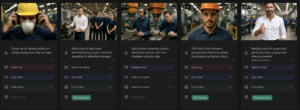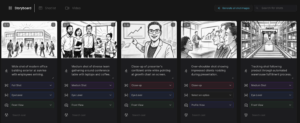Introduction
How to storyboard for instructional design requires balancing educational effectiveness with engaging content delivery. Learning professionals must create experiences that achieve specific knowledge outcomes while maintaining learner attention throughout complex educational journeys.
Unlike entertainment media, instructional content serves measurable learning objectives. Every visual element must contribute to knowledge transfer, skill development, or behavioral change. This educational focus demands strategic planning approaches that traditional storyboarding methods often overlook.
Educational content faces unique challenges including diverse learning styles, varying expertise levels, and retention measurement requirements. Learners consume educational materials in different contexts with varying motivation levels and attention spans.
Traditional storyboarding approaches struggle with educational complexity. Static planning cannot account for interactive assessments, branching learning paths, or adaptive content delivery that modern e-learning systems require.
Modern instructional designers are embracing AI-powered storyboarding solutions that understand educational principles and learning science. Shai Creative’s intelligent storyboard generator incorporates pedagogical best practices into visual planning processes.
Ready to create educational content that achieves measurable learning outcomes? Start developing effective instructional storyboards with Shai Creative and transform your educational content development process.
Why Storyboarding Matters for Instructional Design

Instructional design operates under unique constraints that make comprehensive visual planning absolutely essential. Learning outcomes must be measurable and achievable within specific timeframes. Poor content organization leads to knowledge gaps and failed educational objectives.
Learning Objective Achievement
Educational content exists to create specific behavioral and cognitive changes in learners. Storyboards help designers sequence information logically and ensure every element contributes to objective achievement.
Knowledge scaffolding requires careful progression from basic concepts to complex applications. Visual planning helps instructional designers build appropriate learning sequences that support comprehension and retention.
Assessment integration must align with learning objectives and provide meaningful feedback to learners. Storyboards coordinate these evaluation elements with content delivery for optimal educational effectiveness.
Learner Engagement and Retention
Educational content competes with entertainment media for learner attention. Storyboards help designers incorporate engagement strategies that maintain focus without compromising educational integrity.
Cognitive load management prevents information overwhelm that reduces learning effectiveness. Visual planning helps designers balance content density with processing capacity limitations.
Motivation maintenance requires strategic pacing and reward systems throughout educational experiences. Storyboards plan these motivational elements systematically across learning journeys.
Diverse Learning Style Accommodation
Visual learners need graphic representations and spatial relationships to process information effectively. Auditory learners benefit from verbal explanations and sound-based content. Kinesthetic learners require interactive elements and hands-on activities.
Learning preference integration requires coordinated multimedia approaches that serve different processing styles simultaneously. Storyboards help designers plan these multi-modal experiences systematically.
Accessibility considerations ensure educational content works effectively for learners with different abilities and technological access. Visual planning incorporates these inclusive design requirements from initial development phases.
What Makes a Great Storyboard for Instructional Design

Instructional design storyboards must balance pedagogical effectiveness with engaging content delivery. Each frame should advance learning objectives while maintaining learner motivation and comprehension throughout educational experiences.
Learning Progression Structure
Content sequencing follows educational logic rather than entertainment pacing. Information must build systematically from foundational concepts to advanced applications. Storyboards visualize these learning progressions clearly.
Prerequisite knowledge identification ensures learners possess necessary background information before advancing to complex topics. Visual planning helps designers coordinate these foundational elements appropriately.
Concept reinforcement requires strategic repetition and application opportunities throughout educational content. Storyboards plan these reinforcement moments systematically without creating redundancy or boredom.
Interactive Element Integration
Knowledge checks provide immediate feedback and help learners assess their understanding. These interactive moments require specific timing and presentation planning within educational sequences.
Scenario-based learning creates relevant application contexts that help learners transfer knowledge to real-world situations. Storyboards coordinate these practical elements with theoretical content delivery.
Branching interactions allow personalized learning paths based on individual progress and comprehension levels. Visual planning coordinates these adaptive elements effectively.
Assessment and Evaluation Planning
Formative assessments provide ongoing feedback throughout learning processes. These evaluation points require integration with content delivery and must align with specific learning objectives.
Summative evaluations measure overall learning achievement and course effectiveness. Storyboards coordinate these comprehensive assessments with preceding instructional content.
Performance tracking enables continuous improvement of educational content based on learner success metrics and engagement data.
Traditional vs AI Storyboarding Tools

Shai’s intuitive interface where users can upload a script and generate visual storyboards, complete with scene sequencing, shot duration, and voiceover options — all in one platform.
Traditional instructional design storyboarding relies on manual documentation and static planning methods. These approaches struggle with interactive educational requirements and adaptive learning system coordination.
Manual Method Limitations
Educational complexity overwhelms traditional planning approaches. Learning objectives, assessment integration, and diverse learning style accommodation require sophisticated coordination that manual methods struggle to provide.
Interactive element planning becomes unwieldy with traditional storyboarding. Branching scenarios, adaptive content, and assessment integration create documentation challenges that static planning cannot handle effectively.
Collaboration difficulties arise when instructional design teams include subject matter experts, multimedia developers, and learning management system administrators who need coordinated guidance.
AI-Powered Instructional Storyboarding
Shai Creative’s AI storyboard generator transforms educational content development by understanding learning science principles and pedagogical best practices automatically.
AI storyboard generator showing instructional design sequence planning with learning objectives and assessment integration
Learning objective alignment becomes automatic when AI systems understand educational goals and generate content sequences that support achievement systematically.
Assessment integration coordinates evaluation elements with content delivery to create seamless educational experiences that measure learning effectively.
Discover how AI-powered instructional storyboarding can enhance your educational content while ensuring pedagogical effectiveness and measurable learning outcomes.
Step-by-Step: How to Storyboard for Instructional Design
Define Your Story Goal
Educational content requires clear learning objectives that specify measurable behavioral or cognitive changes. Define what learners should know, understand, or be able to do after completing your instruction.
Target audience analysis goes beyond demographics to include prior knowledge levels, learning preferences, and motivational factors that influence engagement and retention.
Learning context consideration affects content design including whether learners access materials individually or in groups, online or in-person, with or without instructor support.
Success metrics establish measurable criteria for content effectiveness including completion rates, assessment scores, and real-world application evidence.
Identify Key Scenes or Interactions
Break educational content into essential learning moments that advance specific objectives. Focus on concept introduction, skill demonstration, practice opportunities, and assessment points that measure progress.
Knowledge transfer moments deserve special attention in instructional storyboards. Plan how abstract concepts become concrete understanding through examples, analogies, and visual representations.
Skill development sequences require systematic progression from guided instruction to independent practice. Identify scaffolding points that support learner confidence building.
Assessment integration points provide feedback and measurement opportunities without disrupting learning flow. Plan these evaluation moments strategically throughout educational sequences.
Create Visual Frames
Transform educational concepts into clear visual representations that support different learning preferences simultaneously. Consider text, graphics, audio, and interactive elements in comprehensive multimedia approaches.
AI tools accelerate educational visualization by generating appropriate representations for complex concepts. Explore different presentation approaches that serve diverse learning styles effectively.
Information hierarchy guides learner attention toward essential concepts while providing supporting details appropriately. Plan visual emphasis that supports comprehension without overwhelming cognitive capacity.
Accessibility planning ensures content works effectively across different devices, internet connections, and assistive technologies that learners might require.
Add Detailed Annotations
Instructional storyboards require comprehensive educational specifications including timing, interaction requirements, and assessment criteria. Include pedagogical notes that guide development teams through learning science applications.
Learning objective alignment notes connect each content element to specific educational goals. This documentation ensures every component serves measurable learning purposes.
Technical requirements guide multimedia development teams through accessibility standards, platform compatibility, and performance optimization needs.
Assessment specifications detail evaluation criteria, feedback mechanisms, and progress tracking requirements that support learner success measurement.
Review and Collaborate
Implement review processes that include subject matter experts, educational technologists, and representative learners. Their input helps identify knowledge gaps and usability issues before expensive development begins.
Pilot testing integration validates storyboard effectiveness through actual learner feedback and performance measurement. Use this data to refine content before full implementation.
Continuous improvement planning establishes processes for ongoing content optimization based on learner success data and changing educational requirements.
Tips for Optimizing Storyboards for Instructional Design

Learning Science Application
Cognitive load theory guides information presentation density and multimedia integration strategies. Plan content that respects learner processing limitations while achieving educational objectives effectively.
Spaced repetition principles improve long-term retention through strategic review and reinforcement planning. Coordinate these repetition opportunities throughout educational sequences.
Active learning integration requires planned opportunities for learner engagement, reflection, and application. Design interactions that promote deeper processing rather than passive consumption.
Engagement Strategy Implementation
Storytelling techniques make abstract concepts more memorable and relatable. Plan narrative elements that support rather than distract from educational objectives.
Gamification elements including progress tracking, achievements, and challenges can increase motivation when applied appropriately. Balance entertainment with educational effectiveness.
Social learning opportunities encourage peer interaction and collaborative knowledge construction. Plan these community elements where appropriate for learning objectives.
Technology Integration Planning
Learning management system compatibility ensures seamless delivery and progress tracking. Plan technical requirements that work within existing educational technology infrastructure.
Mobile optimization becomes essential as learners increasingly access educational content through smartphones and tablets. Design responsive experiences that work across devices.
Offline access considerations support learners with limited internet connectivity. Plan content delivery methods that accommodate various technological constraints.
Common Mistakes to Avoid
Educational Effectiveness Oversights
Many instructional designers create visually appealing content that fails to achieve measurable learning objectives. Prioritize educational effectiveness over entertainment value in design decisions.
Cognitive overload occurs when content presents too much information simultaneously. Respect learner processing limitations and plan appropriate information density throughout sequences.
Learning Style Misconceptions
Over-reliance on single presentation modes limits accessibility for diverse learners. Plan multimedia approaches that serve different learning preferences without creating redundancy.
Accessibility neglect excludes learners with different abilities from educational opportunities. Incorporate inclusive design principles from initial planning phases rather than retrofitting later.
Assessment Integration Problems
Misaligned assessments measure irrelevant knowledge rather than stated learning objectives. Ensure evaluation elements directly relate to intended educational outcomes.
Inadequate feedback provision limits learner improvement opportunities. Plan specific, actionable guidance that helps learners understand mistakes and improve performance.
Technology Implementation Issues
Platform limitation ignorance leads to content that cannot be delivered effectively through available learning management systems. Research technical constraints before finalizing content approaches.
Performance optimization neglect creates poor user experiences that distract from learning. Plan for various internet speeds and device capabilities that learners might use.
Why Use an AI Storyboard Generator Like Shai
AI-powered storyboarding transforms instructional design from time-intensive manual planning into efficient educational content development that incorporates learning science principles automatically.
Pedagogical Best Practice Integration
AI systems understand educational effectiveness principles and generate content sequences that support learning objective achievement systematically. Incorporate proven teaching strategies without extensive pedagogical research.
Learning science application ensures content design respects cognitive processing principles and retention research. Generate educationally sound approaches that maximize learning effectiveness.
Development Efficiency Benefits
Rapid prototyping allows instructional designers to explore multiple educational approaches quickly and identify methods with highest learning potential before development investment.
Content adaptation capabilities help create versions optimized for different learning contexts, audience levels, and delivery platforms simultaneously.
Quality Assurance Features
Objective alignment verification ensures every content element serves specific educational purposes and contributes to measurable learning outcomes.
Accessibility integration incorporates inclusive design principles automatically, ensuring content works effectively for diverse learner populations.
Transform your instructional design process with Shai Creative and discover how AI-powered storyboarding enhances educational effectiveness while streamlining content development workflows.
Final Thoughts + Next Steps
Effective storyboarding transforms instructional design from intuitive content creation into systematic educational development that achieves measurable learning outcomes. Educational content success requires understanding learning science, engagement strategies, and assessment integration that traditional planning methods often overlook.
Learning effectiveness depends on strategic content organization, appropriate challenge levels, and meaningful feedback systems that support learner success. Professional storyboarding provides frameworks for coordinating these complex educational elements systematically.
AI-powered tools like Shai Creative revolutionize educational content development by automating pedagogical best practice integration while maintaining creative control and educational focus.
Your educational content deserves planning approaches that maximize learning effectiveness while respecting development constraints and learner diversity. Embrace AI-powered solutions that enhance rather than replace instructional design expertise.
Start creating instructional storyboards that achieve measurable learning objectives while maintaining learner engagement and supporting diverse educational needs. Your learners and educational objectives will benefit from this strategic planning approach.